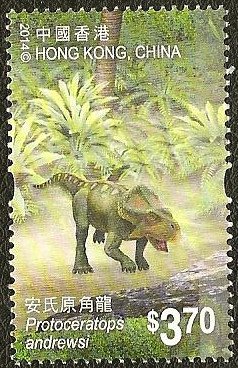Stamp: Protoceratops andrewsi (Hong Kong 2014)
Protoceratops andrewsi (Hong Kong 2014)
20 February (Hong Kong ) within release Chinese Dinosaurs goes into circulation Stamp Protoceratops andrewsi face value 3.70 Hong Kong dollar
| Stamp Protoceratops andrewsi in catalogues | |
|---|---|
| Michel: | Mi:HK 1875 |
Stamp is vertical format.
Protoceratops andrewsi was a herbivorous ceratopsiandinosaur from the Late Cretaceous period (around 75 million years ago). Its fossil was unearthed in the Gobi Desert, Inner Mongolia and it was named after the expedition leader, palaeontologist Roy Chapman Andrews. Protoceratops was 2 to 3 metres long, with a slightly protruding nasal bone, a parrot-like beak, and a huge bony frill behind the skull that protected its neck and back. It usually lived in dense woods and fed on low-lying, ground vegetation. Extremely rich in remains of Protoceratops, China is one of the important excavation sites of Protoceratops fossils.Also in the issue Chinese Dinosaurs:
- Stamp - Daxiatitan binglingi face value 1.70;
- Stamp - Microraptor gui face value 2.20;
- Stamp - Lufengosaurus magnus face value 2.90;
- Stamp - Tuojiangosaurus multispinus face value 3.10;
- Stamp - Protoceratops andrewsi face value 3.70;
- Stamp - Yangchuanosaurus shangyouensis face value 5;
- Souvenir Sheet - Chinese Dinosaurs face value 23.60;
Stamp Protoceratops andrewsi it reflects the thematic directions:
Dinosaurs are a diverse group of reptiles of the clade Dinosauria. They first appeared during the Triassic period, between 243 and 233.23 million years ago (mya), although the exact origin and timing of the evolution of dinosaurs is a subject of active research. They became the dominant terrestrial vertebrates after the Triassic–Jurassic extinction event 201.3 mya and their dominance continued throughout the Jurassic and Cretaceous periods. The fossil record shows that birds are feathered dinosaurs, having evolved from earlier theropods during the Late Jurassic epoch, and are the only dinosaur lineage known to have survived the Cretaceous–Paleogene extinction event approximately 66 mya. Dinosaurs can therefore be divided into avian dinosaurs—birds—and the extinct non-avian dinosaurs, which are all dinosaurs other than birds.

